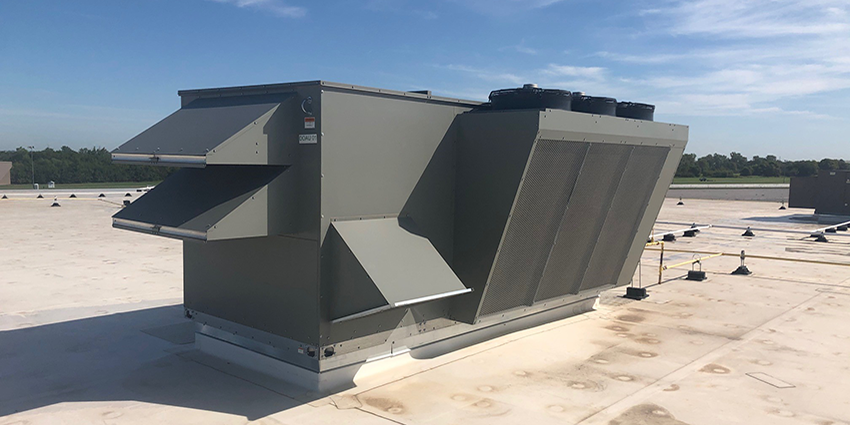Achieve Long-Term Indoor Air Quality with These DOAS Fundamental Features

Investing in dedicated outdoor air systems (DOAS) for your building can ensure lasting indoor air quality (IAQ) for the life of the equipment. This assumes the DOAS units receive regular maintenance and that the DOAS equipment you purchase has the fundamental features designed to protect the unit. That’s right—not all DOAS units arrive from the factory with these features. What are these features? These fundamental attributes fall into two groups--those that protect the unit and enhance performance.
- Painted (powder coated) finish on the cabinet
- Injected foam insulation
- Ultra-quiet condenser fans
- Inverter scroll compressors
- Airflow measurement
- Energy recovery
- Full-width energy recovery wheel
- Enthalpy core
It’s possible to think that all DOAS units are similar, having most, if not all, of the same features. Many do. However, some manufacturers choose to skimp and reduce the base cost but will allow you to “upgrade” for a higher price.
Built to Last
DOAS units must withstand weather and environmental conditions. Heat, cold, wind, snow, rain, and pollution all punish the DOAS cabinet exterior, potentially causing visible signs of this abuse. Other times, it causes problems inside. Two fundamental features that protect against this abuse are a prepainted exterior finish on the DOAS cabinet and an injected foam insulation sealing the interior cabinet.
Powder Coated Exterior Finish
Rusting or peeling finishes create more issues than aesthetics. Good finishes seal the metal, protecting it against chalking and corrosion. Greenheck offers a powder coat finish for DOAS units called Permatector™. Our coating receives salt spray testing that simulates years of continuous abuse. The finish can withstand the most severe conditions, maintaining the integrity of the cabinet.
Injected Foam Insulation
An insulated interior cabinet of a DOAS unit does more than protect the components against temperature extremes that may affect performance. The two-inch injected foam insulation provides R-13 protection. It reduces the amount of exterior condensation and maximizes thermal efficiency.
The injected foam insulation goes into all the possible crevices of the cabinet frame to make sure no voids in the insulation exist. Companies using foam panels cannot guarantee their DOAS units are void-free. Additional benefits of the injected foam insulation are its ability to add extra strength (rigidity) to the cabinet and improve sound attenuation, making for quieter operation.
Built for High Performance
Real-world applications for DOAS units demand cost-effective solutions—many that should be fundamental features. For example, DOAS units should address sound pollution, providing more location options for installation. The units should have compressors that deliver efficient operation tied to the level of demand. Customers should expect consistent airflow and save energy by retaining some sensible and latent heat transfer.
Quiet Condenser Fans
Commercial HVAC units can be loud. Still, good manufacturers consider sound pollution reduction a fundamental feature. One solution to this challenge is using ultra-quiet condenser fans on a DOAS unit. These fans have swept blades that reduce noise by up to 12 decibels. The ramifications of this reduction are significant.
Ultra-quiet condenser fans allow normal conversation even when standing next to the unit while it is operating. By comparison, lawnmowers and chainsaws are much louder. This feature allows for more freedom in placing units on rooftops without workers or building occupants complaining about excessive noise.
Inverter Scroll Compressors
Many manufacturers use conventional digital scroll compressors on their DOAS units. The digital scroll compressor can handle the requirements, but inverter scroll compressors are equally capable and offer better efficiency, particularly at part-load operation. The inverter scroll compressors also offer smooth modulation based on the level of demand.
Digital scroll compressors, whether unloaded or loaded, generate much more sound than inverter scroll compressors until they reach full load.
Airflow Measurement
All DOAS units should leave the factory with the proper airflow level, ensuring the expected performance. However, time and other factors affect airflow. Applying airflow measurement as a fundamental feature on DOAS units provides a visual confirmation that the unit operates as expected. This simple feature removes doubt that it operates at peak performance and reduces troubleshooting time for issues such as dirty air filters, clogged coils, and other challenges.
Energy Recovery
Saving energy is a must, particularly in light of inflation. Energy recovery devices, such as enthalpy wheels and cores, reduce energy costs by transferring latent and sensible heat between the supply and exhaust airstream. Many manufacturers consider these energy-saving devices as fundamental features. Still, it is critical to ensure the energy recovery devices perform as expected.
Enthalpy wheels reuse heat energy leaving a building through air exhaust and combine it with incoming fresh outdoor air. This process limits energy costs by reducing the energy needed to heat or cool the incoming air. Still, the enthalpy wheel must span the entire width of the airstream to ensure the energy recovery benefits are applied to the full 100% outdoor air volume. Costly ramifications happen if you don’t. Reducing energy efficiency, adding unnecessary cooling, and increased moisture are possible. This process, called short-circuiting, results from improper sizing of the wheel or the use of a smaller DOAS cabinet. Short-circuiting is different from the use of an economizer bypass.
Enthalpy cores have a similar use as the wheels, but generally, for applications requiring less CFM. These cores have no moving parts, reducing maintenance costs. They provide energy savings and meet ASHRAE 90.1 minimum efficiencies for sensible and latent heat transfer and offer less cross-leakage (<1% exhaust air transfer ratio (EATR)) than an energy wheel.
Long-term IAQ in buildings is a must for our world. You can ensure great IAQ when DOAS units have the fundamental features that protect and enable high performance. Learn more about DOAS units having those features.


from